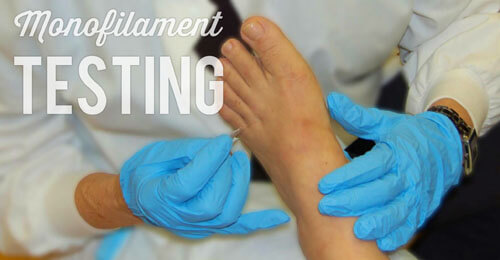How To Perform A Monofilament Test
Diabetic Wound Care: Monofilament Testing
Published on March 11, 2016 by Keisha Smith, MA, CWCMS

Detecting neuropathy in the diabetic foot is crucial for patient intendance, which is why the 10-step monofilament examination is a must when it comes to injury and ulceration prevention.
Healing patients and helping them get on the route to recovery are always at the tiptop of any wound clinician'south list. We are always on alert and in constant assessment mode, looking for ways to prevent farther complications or possible injury. And then when a patient besides happens to exist diabetic, our cess manner goes into overdrive.
One of the almost mutual complications of diabetes is neuropathy, or nerve damage of the extremities. With sensory neuropathy, the patient loses protective sensation and the ability to experience pain and temperature changes. Without protective sensation, the diabetic patient is at an increased chance for foot injury or ulceration, and may not realize annihilation is amiss until there are serious complications.
Neuropathy Screening
This is why testing your diabetic patients for neuropathy is then important. In fact, the American Diabetes Association recommends that we screen diabetic patients for neuropathy annually, at minimum. Once we note any macerated sensation, we should check quarterly.
Ane way to assess protective sensation in the diabetic foot is to perform a Semmes Weinstein 10g Monofilament Test across designated sites on the foot. The examination uses a v.07 monofilament that exerts ten grams of force when bowed into a C-shape against the skin for one 2d.

How to Perform the Semmes Weinstein 10g Monofilament Examination
The test process is equally follows:
- Employ the 10gm monofilament to test sensation.
- Accept patient close his or her eyes.
- Use the filament perpendicular to the skin'due south surface.
- Exist enlightened that the arroyo, skin contact and difference of the monofilament should be approximately i.5 seconds in elapsing.
- Apply sufficient forcefulness to let the filament to bend. (Figure 1).
- Practise not use to an ulcer site or on a callous, scar, or necrotic tissue.
- Do not allow the filament to slide across the skin or make repetitive contact at the test site. Randomly change the order and timing of successive tests.
- Ask the patient to respond, "Yeah," when he or she feels the filament.
- Document response when felt, and exam for awareness (Effigy two).
- Exist aware that neuropathy ordinarily starts in the first and third toes, and progresses to the get-go and third metatarsal heads. It is likely that these areas will be the first to have negative results with the 10gm monofilament. Repeated testing can demonstrate vividly to the patient the progression of the disease.
Record the results on the screening form, noting a "+" for sensation felt, and a "-" for no sensation felt. The patient is said to take an insensate foot if they fail on retesting at simply 1 or more than sites on either foot. Injury is much more probable to occur in these insensate areas and we must accept protective measures. Provide patient teaching verbally and in writing, such as these materials from the American Diabetes Association, and be sure to practise a good shoe fit cess as part of your care plan.
Do yous administer the Monofilament exam?
Are you familiar with the Semmes Weinstein 10g Monofilament Test, and do you administer it on a regular basis to your diabetic patients? Has monofilament testing produced significant results in terms of prevention and cess? We are interested to know about your experiences in diabetic pes testing, so delight get out your comments below.

Click to download this piece of cake-to-use resource for performing pes examinations.
Source: https://blog.wcei.net/diabetic-wound-care-monofilament-testing

0 Response to "How To Perform A Monofilament Test"
Post a Comment